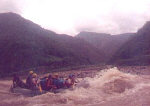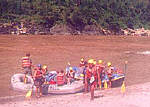White-Water Rafting – Sun Khosi
On the morning of May 28th, we set out with Equator Expeditions to begin our rafting trip on the Sun Khosi river in eastern Nepal. The river is a Class 5 white water river, that runs for over 300 km through the mountains and foothills of the Nepal Himalaya. Our trip began on a rickety old bus, which had a blown tire before we were outside of city limits. Not taking this as an omen, we continued up into the mountainous terrain three hours north-east of Kathmandu.

The trip we were on included 9 full days of white-water rafting and over a week of camping, which started on the Bhote Khosi, a solid class 3/4 river. At the end of this first day, we all stayed in bamboo huts, our last taste of the luxury world for the next 8 days.
In order to describe our experience a little easier, it is necessary that we first explain briefly the grading system used in white-water rafting. Basically, each rapid receives a number grade. The higher the number, the more difficult the rapid. For example:
On our first day of the trip, a large group of backpackers assembled on a beach, where we were given rudimentary instruction in paddling and river safety, and then stuffed in rafts. We had three hours of rolling fun as we raced down possibly the steepest river rafted in Nepal. For over 10 km, we bounced through steady rapids, screamed and tossed into the waves, and as we made mistakes, we learned the hazards of rafting.
My memorable experience came by way of the girl sitting behind me. Tami, who was conned into rafting by some friends, was not enjoying herself. On one very large wave, Tami lost her balance and plunged into the boil. Before falling in, however, she swung around with her paddle, smacking me in the side of the head. Also, as her survival instinct clicked in, she grabbed hold of the nearest object to her. This object, me, was pulled into and under the water. Luckily, we were both okay, but she spent the rest of the afternoon apologizing, and I spent it with a firm grip on the boat.
The Bhote Khosi joined the Sun Khosi early on our second day of rafting. As the two rivers joined, the waters calmed quite considerably and the first day of rafting was flat and peaceful. There were ten clients rafting with the expedition (Tami, much to Tim’s delight was not one of them) and about 6 crew working to keep us fed and happy. There was one gear raft, to carry all of the equipment and the two rafts to carry the people. To our amazement, the food was excellent and served hot and fast everyday. The guides were very professional and they were extremely safety conscious.
Usually everyday we paddled about 30-40 km, shot a few class 3 rapids and lots of class 2. About every second day there was a major class 4-4+ rapid that we had to stop and scout before we ran it. The largest rapid on the river was called Harkapur, it was a mammoth class 4+/5 rapid that had a huge hole right in the middle and an enormous standing wave directly behind it. Our boat was the second to go though and as we were watching them go through we saw them go up and over the first wave then the second, then they just disappeared into the hole and when the boat popped up over the standing wave……it was empty, and upside down.

My stomach fell out at this point, deciding on its own to abandon ship. But we were in the pull of the rapid already and there was no turning back. As we hit the first wave, our guide was screaming at us to paddle harder, harder, harder! With some incredible steering and I imagine a fair amount of luck, we managed to pop up over the wave intact and with all the crew still in the boat. Being in the front of the boat is definitely the best place if you love the thrill of the rapids and getting absolutely soaked.
As we went over the big standing wave in the middle of the rapid, the people at the back of the boat told me that I (being in the front) was directly over their head, straight up, and they thought for sure that we were going to go over. As we came out the end of the rapid, we helped pick up the crew of the other boat, and although they were shaken up a bit, all admittedly thought it was great fun.
It is difficult to recount everything that happened over 9 days of river travel, but there were lots of exciting rapids, and many humorous incidents. When the sun was blazing down, and we were not in difficult water, one boat would routinely wage war upon the other boat. We would call to villagers who would run to the water’s edge and yell "BYE-BYE" at us. Over the course of the trip, we would have well over 300 people yell bye-bye at our boats. Go figure. It was also fun to try swimming through some of the rapids.

One day, we almost had an accident. As we were maneuvering through a difficult section of river, our boat hit a rock, turned sideways and stopped. With this, Michael fell completely out of the boat and started being washed down to some very dangerous rocks. One side of our boat, concentrated on freeing our trapped vessel, while the other side tried to get Michael back in the boat. He managed to grip a rock as he was going downstream, and we got him in the boat. Then, as if choreographed, we spun around, entered a huge rapid and, still spinning, swept past a massive rock and eddy, which would have trapped Michael. He was very thankful.
Some of the most interesting events of the trip, occurred later in the journey. Sometimes near villages, we would pass an ugly, ugly rock, only to realize that it was an unfortunate cow, drifting in the current. Near the river mouth, we were told not to fall in, as sometimes crocodiles come up this part of the river. And, my personal highlight, the pig roast.
One fine night, it was announced that a nearby village would happily sell us a pig, as long as we could butcher and cook it. This sounded great to everyone, but when the time came to cut the meat, it was discovered that only two people knew anything about it. So, under the stars, on a moonlit beach, the happy honeymooners sat together on a tarp, elbow-deep in pig blood and fat. As Mari got a fire going, I laid huge slabs of neatly trimmed pork on a make-shift grill. Canada, in general, was given a big fan-fare at the end of that evening.
On June 5th, our trip came to an end. We reached the rice plateau region, and the rapids stopped. Two things started at this point though, roads and Giardia. The entire group received as a bonus, a rousing round of diarrhea.
We said good-bye to our group who boarded a bus to Kathmandu, and we headed east to the town of Khakarbitta, on the Indian border. We took a room, luxury by our standards, and ended our stay in Nepal the next day, by watching game 4 of the Stanley Cup Finals on satellite T.V.